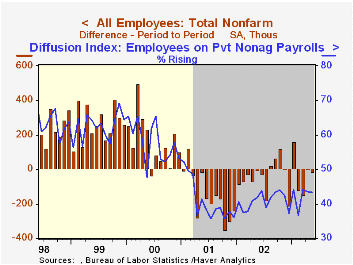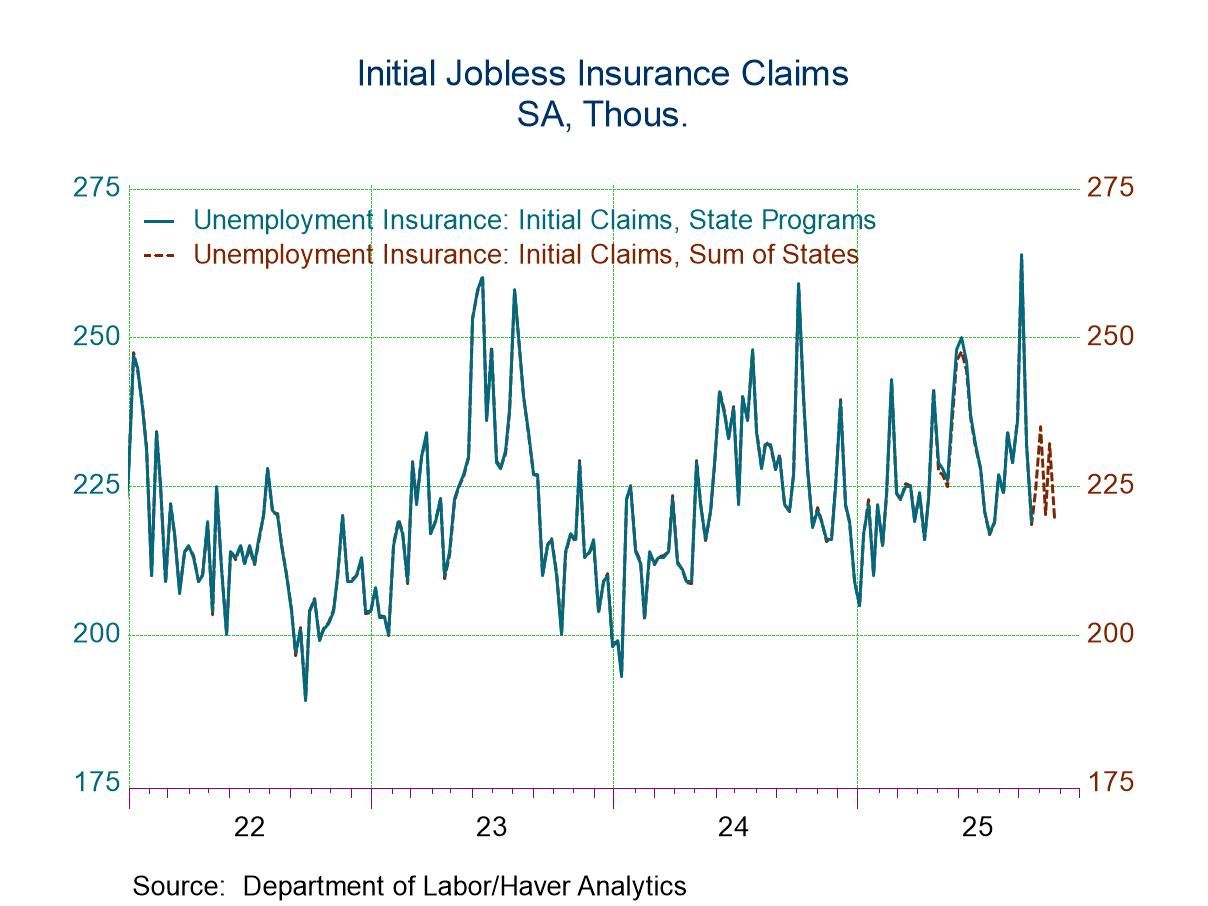 Global| Jun 06 2003
Global| Jun 06 2003Unemployment Rate Highest Since 1994, Payrolls Fell
by:Tom Moeller
|in:Economy in Brief
Summary
The unemployment rate rose to 6.1% in May, matching Consensus expectations. It was the highest rate of unemployment since July 1994. Employment fell 200,000 (+0.7% y/y), the third down month this year. The labor force rose 12,000 [...]

The unemployment rate rose to 6.1% in May, matching Consensus expectations. It was the highest rate of unemployment since July 1994. Employment fell 200,000 (+0.7% y/y), the third down month this year. The labor force rose 12,000 (+1.1% y/y).
Nonfarm payrolls fell 17,000 in May, slightly less than the Consensus expectation for a 25,000 decline. In the last two months the rate of decline in payrolls eased but payrolls still are down 0.1% year to date. Several changes were introduced to the payroll survey.
The one month diffusion index for nonfarm payrolls dipped to 43.3 and prior months' figures were revised down, suggesting poor hiring prospects. The three month diffusion index did rise to a still low 43.0. By measuring the breadth of hiring increases, these indexes are leading indicators of job growth.
Where Jobs Fell: The number of factory sector jobs fell 53,000 (-0.4% m/m, -4.1% y/y) and are down 1.9% year to date. The one-month diffusion index for the factory sector rose to 28.0 from an April figure that was revised down to 14.9 from 33.8. Retail hiring fell 14,000 (-0.5% y/y). Government employment fell 25,000 (+0.1% y/y). Jobs in the transportation & warehousing industries fell 4,000 (-1.9% y/y) for the fourth decline this year. Jobs also were shed in the leisure, information, and wholesale trade sectors.
Where Jobs Rose: Construction jobs rose 26,000 (1.0% y/y) for the fourth gain this year. Jobs in the financial industries rose 12,000 (1.8% y/y for the ninth consecutive monthly gain. Professional and business services jobs rose 48,000 (-0.0% y/y).
The index of aggregate hours worked (employment times hours worked) was unchanged (-1.5% y/y). So far in 2Q hours worked are 0.4% below 1Q.Over the last ten years there has been a 59% correlation between the quarterly change in aggregate hours worked and real GDP. That correlation is down from 87% in the 1980s due to the recent acceleration in productivity growth.
Average hourly earnings rose 0.3% following two months of no change.
With the May employment report, several major changes were made including conversion of the payroll figures to the North American Industry Classification System (NAICS), the completion of a sample redesign and the introduction of concurrent seasonal adjustment which updates seasonal factors each month.
For a more complete discussion of these changes, view the press release for today's figures from the Bureau of Labor Statistics.
The nonfarm payroll employment figures are based on reports provided to the US Labor Department by businesses, while the figures from which the unemployment rate is derived are based on a survey of US households.
| Employment | May | April | Y/Y | 2002 | 2001 | 2000 |
|---|---|---|---|---|---|---|
| Payroll Employment | -17,000 | 0 | -0.3% | -0.9% | 0.2% | 2.2% |
| Manufacturing | -53,000 | -90,000 | -4.1% | -5.5% | -4.2% | -0.4% |
| Average Weekly Hours | 33.7 | 33.7 | 33.9 | 33.9 | 34.0 | 34.3 |
| Average Hourly Earnings | 0.3% | 0.0% | 3.2% | 2.9% | 3.8% | 3.9% |
| Unemployment Rate | 6.1% | 6.0% | 5.8% | 5.8% | 4.8% | 4.0% |
Tom Moeller
AuthorMore in Author Profile »Prior to joining Haver Analytics in 2000, Mr. Moeller worked as the Economist at Chancellor Capital Management from 1985 to 1999. There, he developed comprehensive economic forecasts and interpreted economic data for equity and fixed income portfolio managers. Also at Chancellor, Mr. Moeller worked as an equity analyst and was responsible for researching and rating companies in the economically sensitive automobile and housing industries for investment in Chancellor’s equity portfolio. Prior to joining Chancellor, Mr. Moeller was an Economist at Citibank from 1979 to 1984. He also analyzed pricing behavior in the metals industry for the Council on Wage and Price Stability in Washington, D.C. In 1999, Mr. Moeller received the award for most accurate forecast from the Forecasters' Club of New York. From 1990 to 1992 he was President of the New York Association for Business Economists. Mr. Moeller earned an M.B.A. in Finance from Fordham University, where he graduated in 1987. He holds a Bachelor of Arts in Economics from George Washington University.






